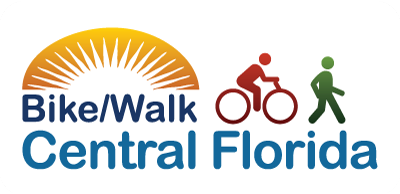 Recent Report Details National Bicycling and Walking Statistics
Recent Report Details National Bicycling and Walking Statistics
The Alliance for Biking & Walking released their 2014 Bicycling and Walking in the U.S. Benchmarking Report and guess who takes the cake for the worst in the nation? You got it – Florida. Our state takes #1 worst spot in the nation for pedestrian fatalities, with an average of 481 pedestrians killed each year since 2003 to 2011. And let’s not forget the average 105 bicyclists killed each year since 2003 to 2011.
The report concluded the number of fatalities are inversely correlated to the number of walkers and cyclists. Since few people walk or bike in Florida, no wonder we take first place. That’s why it’s Bike/Walk Central Florida’s mission, purpose, quest, goal, and mantra is to normalize biking and walking – where the unexpected is now the expected.
The Report includes new data on bicycling and walking in all 50 states, the 52 largest U.S. cities, and a select number of midsized cities.
Biking and walking fatality rates among the nation’s highest
Biking and walking fatality rates have been on the decline for decades, but the percentage of fatalities has increased from 12.6 percent in 2003 to 15.8 percent in 2011. Unfortunately, Florida is a big part of this problem, ranking as the worst in the nation for pedestrian fatality rates with an average of 481 pedestrian and 105 bicyclists killed each year. The risk facing seniors is higher – seniors represent 10 percent of all pedestrians and 6 percent of bicyclists, yet account for 19 percent of all pedestrian fatalities and 12 percent of bike fatalities.
The Report concludes that there are lower bicyclist and pedestrian fatality rates where there are more people biking and walking because drivers are more likely to operate carefully and safely around cyclists and walkers when they’re used to seeing them. Only 0.6 percent of Florida’s commuters bike to work and 1.6 percent walk, placing us 42nd in the nation. So why aren’t more of our commuters biking or walking to work? Climate may play a factor. Montana and Alaska have some of the coldest temperatures in the nation, yet boast the highest levels of bicyclists and pedestrians. Comparing rates of average precipitation and days below freezing did not reveal any clear trends, but a relationship was found between lower rates of bicyclists and pedestrians and the number of days above 90 degrees. (I’m looking at you Orlando. You’ve got 105 of those every year.)
Florida’s goals
Since 2010, 11 states have added new goals to decrease fatalities and increase bicycling and walking. Florida’s goals include increasing walking and decreasing pedestrian and bicyclist fatalities. We are among 20 states that have set performance measures for the goal of decreasing fatalities. Our existing Complete Streets policy joins the 54 percent of states now actively pursuing Complete Streets legislation or policies. A Complete Street accommodates people of all ages and abilities traveling on foot, on bicycle, in transit and in cars.
While nationwide few federal dollars go toward bicycling and walking, Florida ranks #2 in the nation, contributing more than $80 million dollars year or 3.5 percent of its annual budget. The national average is 2.1 percent. And while 37 states have zero funding for state safety policies, Florida is #1 in the nation with 4.3 percent funding to bicyclists and pedestrians.
We’re utilizing education to a high degree too – 46 percent of our schools participate in Safe Routes to School (the national average is 17.1 percent). The Share the Road campaign, motorist/bicyclist interaction in the state driver’s manual, driver’s license test questions about bicyclists, and a state bicyclist manual further contribute to educating the public about bicyclist and pedestrian safety.
What’s next?
The Alliance outlines recommendations for nationwide improvement like adopting policies and street designs that improve bicycling and walking; collecting data on bicycling and walking including a representation of people from different racial and ethnic groups, income levels, genders, and abilities; working together to leverage funding for bike/pedestrian infrastructure; and implementing initiatives and opportunities that encourage biking and walking.
Here in the Sunshine State, we should follow these recommendations as well as some more personalized goals like hosting an annual statewide bike/pedestrian conference to allow professionals opportunities for continuing education, networking, and collaboration. We also need to advocate for bicycling enforcement to be taught in Police Officer Standards and Training (POST) courses as well as in police academy curriculum to enable our police officers to understand and uphold bicyclist and pedestrian rights in crashes, ticketing, and most importantly in setting a good example for other motorists.
With new goals in mind, it’s still important to remember that more people tend to bike or walk to work when a city has strong biking and walking advocacy. More and more organizations like Bike/Walk Central Florida are working together to organize safer, more accessible streets for bicycling and walking.
About the Alliance for Biking & Walking
The Alliance for Biking & Walking is the North American coalition of state and local bicycling and walking advocacy organizations. Our mission is to create, strengthen, and unite state/provincial and local bicycle and pedestrian advocacy organizations. Since our founding in 1996, we have grown from 12 to over 220 member organizations representing 49 U.S. states and the District of Columbia, five Canadian provinces, and two Mexican states. Read more here.


